Briefing: ‘Battle of Britain’ movie airplanes sold
Will be restored by U.S., European collectors
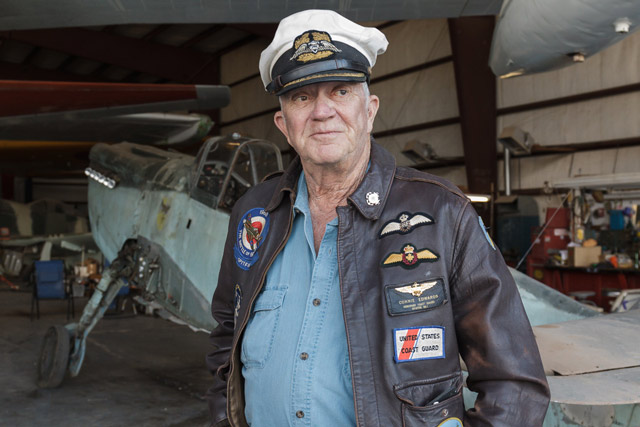
Connie Edwards at his west Texas ranch with a rare two-seat Buchon that appeared in the 1969 movie Battle of Britain. Edward coordinated the aerial scenes and took the airplanes as payment.
The rare fighters from the 1969 Battle of Britain movie have been sold to restorers in the United States and Europe, according to the agent handling the sale.
Wilson Connell “Connie” Edwards, the irascible 80-year-old pilot who coordinated the movie stunts and took the airplanes as payment, has stored most of them in a dusty, west Texas hangar for more than 40 years.
FAA warns flight sharing services
Agency position appears consistent
By Jim Moore
The FAA has advised two online startups that participating pilots would violate longstanding regulations and legal principles by accepting passengers referred through the respective services, and sharing the cost of the flights with those passengers.
While each of the companies, based in the Boston area and operating for several months, maintains they are operating within the regulatory limits, FAA attorneys disagreed in legal interpretations to AirPooler launched in 2013, followed by an interpretation delivered to Flytenow, which went live in January. Officials from both companies disputed the FAA’s legal analysis, and vowed to seek additional clarification.
Both companies argued that their services, essentially online matchmaking for pilots and passengers interested in the same destinations (including local flights, in the case of Flytenow), do not constitute commercial transportation, noting that participating private pilots would pay at least their pro rata share of allowable expenses, as defined by FAR 61.113 (c).
FAA attorneys opined that there is another issue involved, regardless of a given pilot’s certificate level: Advertising upcoming flights, even if the pilot chooses the itinerary, constitutes “holding out,” a common law principle (that predates aircraft) in which transportation is offered to any and all who are interested. That, the FAA said, turns a private flight with shared expenses into a commercial operation (in legal terms, a “common carrier”) that requires a commercial operator or air carrier certificate as stipulated in Part 119.
There are a few exceptions that allow pilots to fly for compensation without holding a commercial operator certificate, such as certain air tours, flight instruction, aerial survey work, and others listed under Part 119.1, along with foreign operations covered by 14 CFR Part 375.
Email [email protected]
Medical certification reform will happen
Rep. Rokita says bill is ‘very important’
By Sarah Deener
 As momentum builds for the General Aviation Pilot Protection Act (GAPPA), a co-author of the bill expressed optimism that medical certification reform will happen, either by FAA rulemaking or legislation. Rep. Todd Rokita (R-Ind.) said that efforts to reform the third class medical are moving forward: Additional co-sponsors have signed on to the bill, which would lift the burden of the third class medical from many pilots; and the FAA has promised rules addressing medical reform. Lawmakers will “keep up the flank” to make sure reform happens, he said.
As momentum builds for the General Aviation Pilot Protection Act (GAPPA), a co-author of the bill expressed optimism that medical certification reform will happen, either by FAA rulemaking or legislation. Rep. Todd Rokita (R-Ind.) said that efforts to reform the third class medical are moving forward: Additional co-sponsors have signed on to the bill, which would lift the burden of the third class medical from many pilots; and the FAA has promised rules addressing medical reform. Lawmakers will “keep up the flank” to make sure reform happens, he said.
As of September 22, the number of co-sponsors of the GAPPA in the House had reached 150. Rokita said pilots can help grow the number in the House and garner support in the Senate by contacting their representative and senators. “It is very important,” he said. “You are listened to. We are listened to. You have got to call in, you have got to email and write in.” At latest count, the Senate version of the bill had 20 co-sponsors.
The FAA’s proposed rule in response to an AOPA/Experimental Aircraft Association petition for medical reform has been passed from the FAA to the Department of Transportation and now the Office of Management and Budget. Rokita signed to two letters to Transportation Secretary Anthony Foxx in August, one with Rep. Sam Graves (R-Mo.) and Sen. Mark Begich (D-Alaska) and another with other members of the General Aviation Caucus, urging the department to expedite the rulemaking process.
“Hopefully the FAA sees that this is a commonsense measure. This is about safety. This is about the economy. This is about getting more pilots back into aviation again, and we have data to back it up. Ten years of experience in the light sport aircraft certification arena shows that we don’t need to have this third class medical regulatory regime to have safety,” Rokita said. Calling the change a “win-win for everybody,” Rokita said that the FAA could direct its focus to more important matters and there could be more, safer pilots. Rokita said that he and other lawmakers will keep the pressure up on the rulemaking process, but noted that even if the FAA proposed rules aren’t what pilots want, the legislative effort continues.
“I am confident,” he said. “And if these rules aren’t exactly what we want, or not nearly what we want, we have the ability to comment and change them. And then we’re going to keep this legislation up in case it’s not what we want, or in case they decide not to do anything,” he said.
Email [email protected]
View the video: See the interview with Rep. Rokita on AOPA Live This Week.
Boston adding air and space museum
 A public campaign begun two years ago is building momentum as volunteers and staff for the proposed Massachusetts Air and Space Museum at Laurence G. Hanscom Field Airport near Boston. The group has $250,000 and is looking for more than $100 million in a city known for strong public financial support for museums. It could open as early as 2019.
A public campaign begun two years ago is building momentum as volunteers and staff for the proposed Massachusetts Air and Space Museum at Laurence G. Hanscom Field Airport near Boston. The group has $250,000 and is looking for more than $100 million in a city known for strong public financial support for museums. It could open as early as 2019.
A key to the museum’s design is interactive exhibits for kids, says volunteer Robert Segal who is in charge of exhibit designs. A “do touch” museum as opposed to a “do not touch” museum can encourage interest in the federal Department of Education’s emphasis on science, technology, engineering, and math (STEM), Segal said.
The museum is to be built in a U shape facing the actual airport control tower, with an observation tower attached to the museum to watch airport activities. Property at the airport is already designated for the museum, and volunteers have set up a headquarters office at Hanscom Field. —Alton K. Marsh
Web: www.massairspace.org
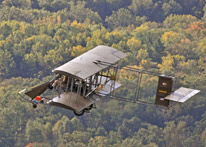 Fundraising to replace Wright B Flyer begins
Fundraising to replace Wright B Flyer begins
Fundraising has begun to replace the “Brown Bird” look-a-like of the world’s first production airplane, the 1911 Wright B Flyer based in Dayton, Ohio. The present one has flown above the Rose Bowl and the Statue of Liberty. Late Apollo astronaut Neil Armstrong once flew it. It is made of modern parts manufactured to present airworthiness standards, but it is time to consider its replacement, Wright B Flyer President Jay Jabour said. —AKM
Air mail arrows still visible
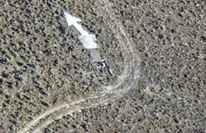 How do you navigate across the country at night? In the mid-1920s to 1933 the answer would have been “beacons and concrete arrows.” Today some of the concrete arrows measuring 50 to 70 feet are still evident. The one in the photo was taken from the AOPA Sweepstakes Waco by Randy and Heather McCoy near their hometown of Winnemucca, Nevada.
How do you navigate across the country at night? In the mid-1920s to 1933 the answer would have been “beacons and concrete arrows.” Today some of the concrete arrows measuring 50 to 70 feet are still evident. The one in the photo was taken from the AOPA Sweepstakes Waco by Randy and Heather McCoy near their hometown of Winnemucca, Nevada.
The concrete arrows served as a foundation for 50-foot-tall beacons plus a shed that either housed gas for the beacon or a generator. During World War II many of the concrete arrows, each one pointing to the tower three to 10 miles ahead, were bulldozed for fear that enemy pilots could use them for navigation. The route of beacons and sometimes just bonfires stretched from New York City to San Francisco with spur routes to cities along the way. Emergency landing fields were located every 25 to 50 miles and marked by beacons that could be seen for 75 miles.
While we’re reminiscing about the past, it should be noted that Montana continues to operate 19 of the beacons in the state’s western mountains although they have been updated. The last tower to be decommissioned by the FAA sits in the National Air and Space Museum. —AKM
Formation wingwalkers wow Europe
 The British-based AeroSuperBatics team has performed formation aerobatics for 27 years all over the world. Also known as the Breitling Wingwalkers because of their sponsorship by the legendary watchmaker, the all-female team experience speeds up to 150 mph and G-forces up to 4G. Pilots for the team are all male.
The British-based AeroSuperBatics team has performed formation aerobatics for 27 years all over the world. Also known as the Breitling Wingwalkers because of their sponsorship by the legendary watchmaker, the all-female team experience speeds up to 150 mph and G-forces up to 4G. Pilots for the team are all male.
To get an idea of what they do, look at what the team website says about performer Lydia Beadle: “Lydia Beadle’s favorite move is the Mirror, where she hangs upside down on the inverted airplane while reaching for the hands of the wingwalker flying below her.” Beadle is the team’s youngest performer at age 21.
The team has performed at 2,500 events before six million people while strapped to the top wings of Boeing Stearman biplanes, sometimes in two- or four-plane formation. They hang on through aerobatic moves including loops. —AKM
Web: www.aerosuperbatics.com
Watch the video
Wingfoot One takes flight
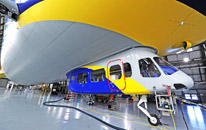 Goodyear’s Ohio-based semi-rigidairship Wingfoot One built by Germany’s ZLT Zeppelin Luftschifftechnik has begun service above major events. Carrying up to 12 passengers, it can cruise at 43 knots or, if in a hurry, can reach more than 60 knots at maximum power from three new four-cylinder 200-horsepower Lycoming IO-360 engines. (Goodyear has used refurbished Continental engines on its two blimps, which cruise at 30 knots.) The Wingfoot name comes from the company symbol, a foot with a wing, which in turn is based on the Roman god Mercury. —AKM
Goodyear’s Ohio-based semi-rigidairship Wingfoot One built by Germany’s ZLT Zeppelin Luftschifftechnik has begun service above major events. Carrying up to 12 passengers, it can cruise at 43 knots or, if in a hurry, can reach more than 60 knots at maximum power from three new four-cylinder 200-horsepower Lycoming IO-360 engines. (Goodyear has used refurbished Continental engines on its two blimps, which cruise at 30 knots.) The Wingfoot name comes from the company symbol, a foot with a wing, which in turn is based on the Roman god Mercury. —AKM
Where is Barrington Irving?
Flying the world, again
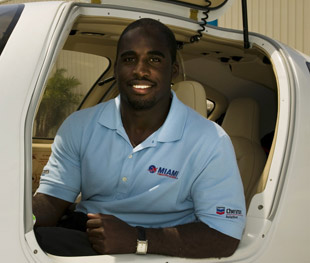 Pilot Barrington Irving in September launched his Flying Classroom project, created to offer interactive science, technology, engineering, and math (STEM) education to schoolchildren around the world.
Pilot Barrington Irving in September launched his Flying Classroom project, created to offer interactive science, technology, engineering, and math (STEM) education to schoolchildren around the world.
Irving and his team will fly Inspiration III, a Hawker 400XP business jet, to North America, Asia, Indonesia, and Australia to demonstrate real-life STEM applications, along with history, geography, and humanities. Over three school years, he will go on 16 ground, air, and sea expeditions. This journey isn’t like the one taken in 2007, said Irving. “That trip was done with a turboprop. I’ll be using a business jet and transforming it into a flying classroom,” he said. “We have to get directly into the classroom so we can inspire kids to become pilots and engineers.”
Among Irving’s expeditions are a trip to U.K.-based game maker Maverick. “We are going there to show how geometry and algebra are important to game design,” he said. “We’re also traveling to Nike to show, really soon, you will be able to use a 3-D printer to print out shoes without having to go to a store.” It all takes an education, he added. “We hope that this will help move kids into STEM careers. No matter what anyone tells you—you’re too poor, not popular in school, not fast in the classroom—anything is possible. I didn’t have much, but I had a brain and got a good education. We all have brains that make things possible.”
Web: www.experienceaviation.org
Pipistrel introduces electric trainer
Expected to cost $132,000
By Thomas A. Horne
 Pipistrel, the Slovenian manufacturer of several eco-friendly, electrically powered airplanes, has announced its new two-seat trainer, the WATTsUP. A proof-of-concept design, the WATTsUP is powered by an 85 kW (approximately 113 horsepower) electric motor that weighs just 31 pounds. Its battery pack can be charged in an hour, then produce enough energy to fly for one hour, with a 30-minute power reserve. Climb rate is 1,000-plus fpm, according to Pipistrel.
Pipistrel, the Slovenian manufacturer of several eco-friendly, electrically powered airplanes, has announced its new two-seat trainer, the WATTsUP. A proof-of-concept design, the WATTsUP is powered by an 85 kW (approximately 113 horsepower) electric motor that weighs just 31 pounds. Its battery pack can be charged in an hour, then produce enough energy to fly for one hour, with a 30-minute power reserve. Climb rate is 1,000-plus fpm, according to Pipistrel.
Pipistrel CEO Ivo Boscarol said, “With the ever-growing cost of fuel, it is time to rethink pilot training. Our solution is the first all-electric trainer. Technologies developed specially for this aircraft cut the cost of training by as much as 70 percent, making flying more affordable than ever before.”
The WATTsUp’s engine was developed by Siemens AG. Siemens Executive Vice President Frank Anton said that the company “is building electric drive systems with the highest power-to-weight ratios for aircraft propulsion.”
What’s more, in the traffic pattern 13 percent of the engine’s energy is recuperated on each approach, a Pipistrel press release asserted. The airplane meets both ASTM and European microlight criteria.
Pipistrel expects the WATTsUP to go to market in 2015, and sell at a target price below $132,000.
Email [email protected]
75 years ago this month
AOPA was founded May 15, 1939.
It is November 1939. America celebrates two Thanksgivings. In an effort to bolster the economy during the Depression, President Franklin D. Roosevelt moves the holiday one week earlier to help with Christmas sales. But most of the nation does not observe this change and some Americans celebrate on November 23 and some on November 30. Unemployment in the United States is at 17.2 percent.
November 1
First animal conceived by artificial insemination (a rabbit).
First jet plane, the Heinkel He 178, is demonstrated to the German Air Ministry.
November 4
The first air-conditioned automobile—a Packard—is exhibited in Chicago.
The Neutrality Act of 1935 is repealed.
November 8
Failed assassination attempt on Adolf Hitler in Munich.
November 11
Kate Smith first sings God Bless America.
November 15
U.S. Social Security Administration approves first unemployment check.
Nazis begin mass murder of Warsaw Jews.
November 16
Al Capone freed from Alcatraz.
November 30
USSR invades Finland, bombs Helsinki.
“All of the airplanes have been sold, and they will be gone by the end of the year,” said Simon Brown of Platinum Fighters, which handled the sale. “We had multiple full-price offers for each airplane. They are going to three different buyers who plan to restore them to top flying condition.”
An original Mark IX Spitfire is the jewel of the fleet and will return to England. Six Buchons (Bf-109s built under license in Spain) will go to a collector in Europe. And an original P-51 Mustang (that didn’t appear in the movie) will be restored at a United Sates restoration shop. Brown declined to identify the buyers.
“These are barn finds—the last unrestored aircraft of their kind in the world,” Brown said. “They went for about 20 percent more than flyable aircraft because they are so completely original.”
Edwards and his many and varied aircraft were featured in the August 2014 issue of AOPA Pilot magazine (“A Tall Tale That’s True”). Edwards had intended to give the movie airplanes to his son, Wilson Connell “Tex” Edwards, but the younger man was killed in a traffic accident about one year ago.
Edwards made a fortune in the oil, ranching, and stone business and kept his aircraft on a private strip at his Big Spring home. He has more than a dozen other rare aircraft including a Grumman Albatross, Mallard, and two Consolidated PBYs that weren’t included in the sale.
Edwards unapologetically set high prices totaling more than $15 million for the Battle of Britain airplanes and absolutely refused to negotiate. Brown said the tactic worked.
“Connie got his price,” Brown said. “In fact, he got a little more than he was asking. The Buchons were sold in 24 hours, and the rest were under contract within four weeks.”
By Dave Hirschman
Email [email protected]
13: The number of flyable Spitfire fighters in the United States.
View the video: Tall tale: Historical relics hidden in barns, a video from AOPA Live This Week.


